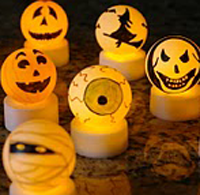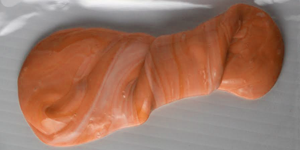Slime, Catapults, and Halloween Science
Inspire hands-on learning by getting creative. You can easily turn chemistry and physics science experiments into Halloween-inspired activities that your students will enjoy!
Halloween is tomorrow. Hopefully you've found, stitched, glued, or otherwise assembled all necessary gear for the big night of knocking door to door for fun treats. To keep you in the mood, we've got two more hands-on science suggestions, both of which are fun ways to tie science into the festivities, even after the fact!
Slime
To hook some kids, it's that simple. You need slime. For the rest of us, despite the gross factor, the science of slime, when you get right down to it as it oozes through your fingers, is chock full of squishy but fascinating chemistry! Mixing up a stretchy putty or experimenting with Oobleck, Ooze, or some other non-Newtonian fluid is classic, hands-on, tactile fare for the younger set. They love to get really hands on with their chemistry, because it feels good, or cold, or slippery, or bouncy, or some other wonderful adjective that a toddler or early elementary student might toss out to describe how a new mixture feels. But these sbstances offer excellent hands-on learning moments for older students, too!
Colloids and Polymers, Anyone?
Slime, especially glowing, green, the color-of-some-unearthly-snot slime, fits right in with the fun but eerie side of Halloween. So why not make your own, but turn the "making" into a fun science activity—one with a clear take-away, slime you can dig your hands into or bounce around.
In order to keep things shrouded in mystery, we don't want to tell you exactly which formula to use or how to modify one recipe or the other to achieve the best and slimiest consistency. Instead, we want you to experiment!
These two Project Ideas have the goods you need to know, including background information that will let you and your kids talk about polymers and colloids and better understand the properties of each mixture you try.
- Slime Chemistry: make your own slime product and experiment with changing the amount of a key ingredient for different properties of the slime.
- Making Mixtures: How Do Colloids Size Up?: experiment with corn starch and water to mix up some Oobleck or Ooze. Colloids have interesting properties because sometimes they seem like a liquid and sometimes they seem like a solid. What kind of slime factor can you concoct?
You could mix up a batch of both mixtures, a putty and a colloid. Or, pick one or the other. Both are fun to make with kids. If you have some glow-worthy paint you can mix into the batch (try a small quantity), you might be able to turn a bit of family or after-school science into an awesome trick or treat moment!
Catapult
Catapults have a long history of launching things, including fiery things, into enemy territory. Brought into the realm of hands-on science, a catapult is a super way to experiment with physics principles and the math that goes along with correctly launching something so that it goes where you want it to go.
Science Buddies has a suite of Project Ideas that use the Ping Pong Catapult:
- Bombs Away! A Ping Pong Catapult
- Under Siege! Use a Catapult to Storm Castle Walls
- Bet You Can't Hit Me! The Science of Catapult Statistics
- Launch Time: The Physics of Catapult Projectile Motion
These projects are all great explorations individually, but the suite allows students to use a single kit and experiment with multiple angles (literally!) related to similar physics-based scenarios and questions. How can you tie the catapult in with Halloween science?
No, not launching pumpkins! But what else might you try? How many individually wrapped small candy bars will come home Halloween night? Is there a game you and your students might make up to launch candies into a Halloween bucket, box, or bag? What might you explore about the difference in flight pattern and trajectory of different candies based on variables like size or shape?
Or, if you want to stick with ping pong balls because they are light, will only fly a certain distance, and won't be a concern if they wind up lost under the couch, grab a permanent marker and turn them into jack-o-lanterns and other Halloween creatures for added catapult fun—without the mess of pumpkin guts! (A quick Internet search on "Halloween ping pong balls" turns up all kinds of great visual examples of how you can uplevel ordinary ping pong balls for Halloween. A dozen eyeballs anyone?)
Warning: when using the ping pong catapult, especially if you are launching objects other than ping pong balls, be sure you have plenty of space and don't launch towards windows, screens, or other breakable things. This may be a science activity to take outside the weekend after Halloween and have some candy-launching fun at a local park!
Setting Siege for Halloween Fun
A quick Internet search on "Halloween ping pong balls" turns up all kinds of great visual examples of how you can transform ordinary ping pong balls for Halloween fun. A dozen eyeballs anyone? Get creative! Mummies, ghosts, Frankenstein, pumpkins, bats, witches... decorate a set of ping pong balls with your kids and then have fun launching them into the trick-or-treat candy basket with the Ping Pong Catapult. Your kids will have fun experimenting with science and the physics behind successfully getting the balls to the target! [Image: Booturtle]
Categories:
You Might Also Enjoy These Related Posts:
- 15 STEM Gifts & Science Kits You'll Feel Good About Giving
- 13 Boat Science and Submarine Science Projects and Experiments
- July 4th STEM! Summer Science Picks for Independence Day!
- 12 Science Kits for Summer Science Experiments and Discovery
- 15 Science Projects to Make and Give for Father's Day
- Ready, Set, Go! (Awesome Summer Science Experiments)
- Awesome Summer Science Experiments
- 10 STEM Activities with Cardboard Tubes











